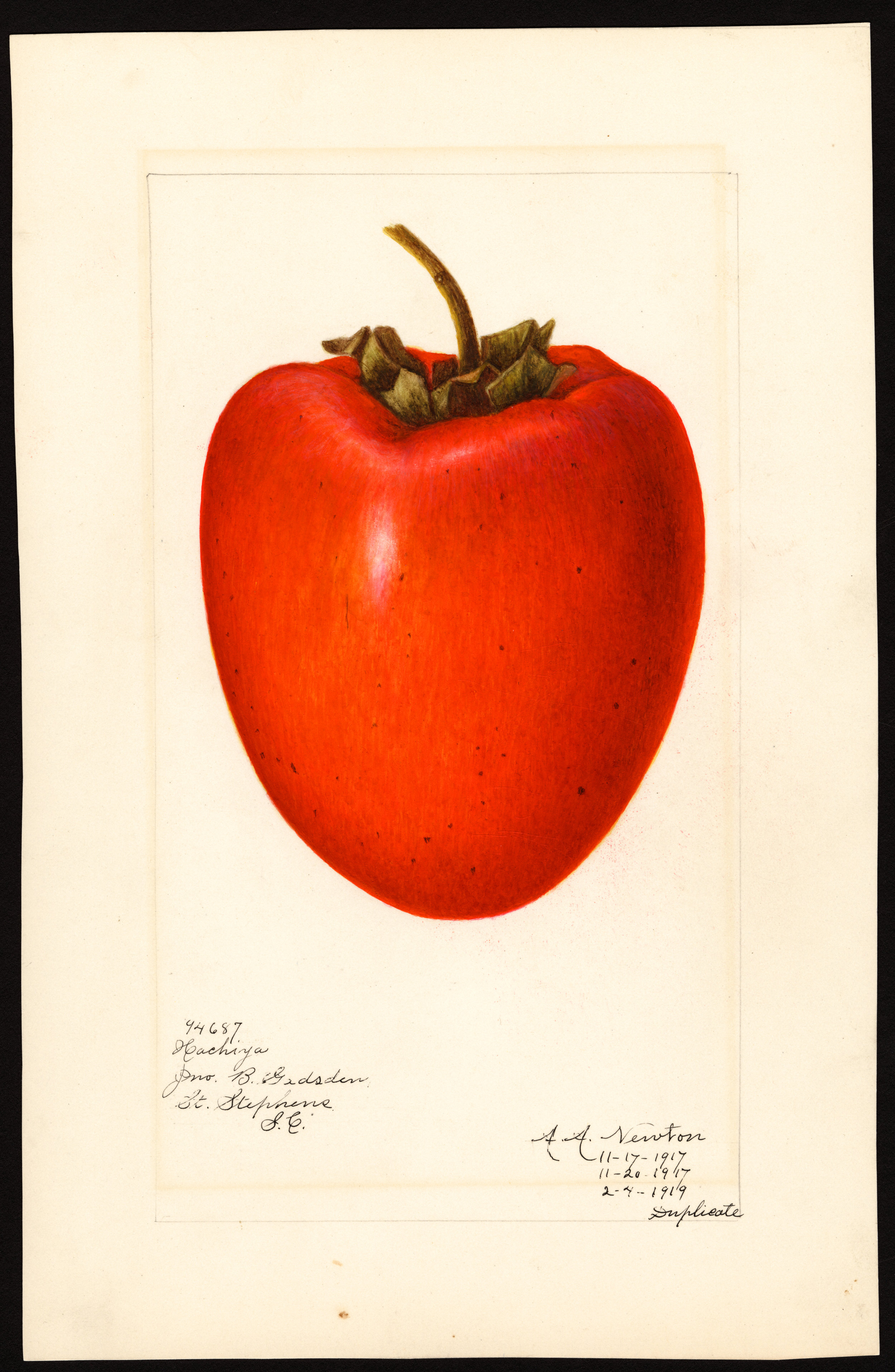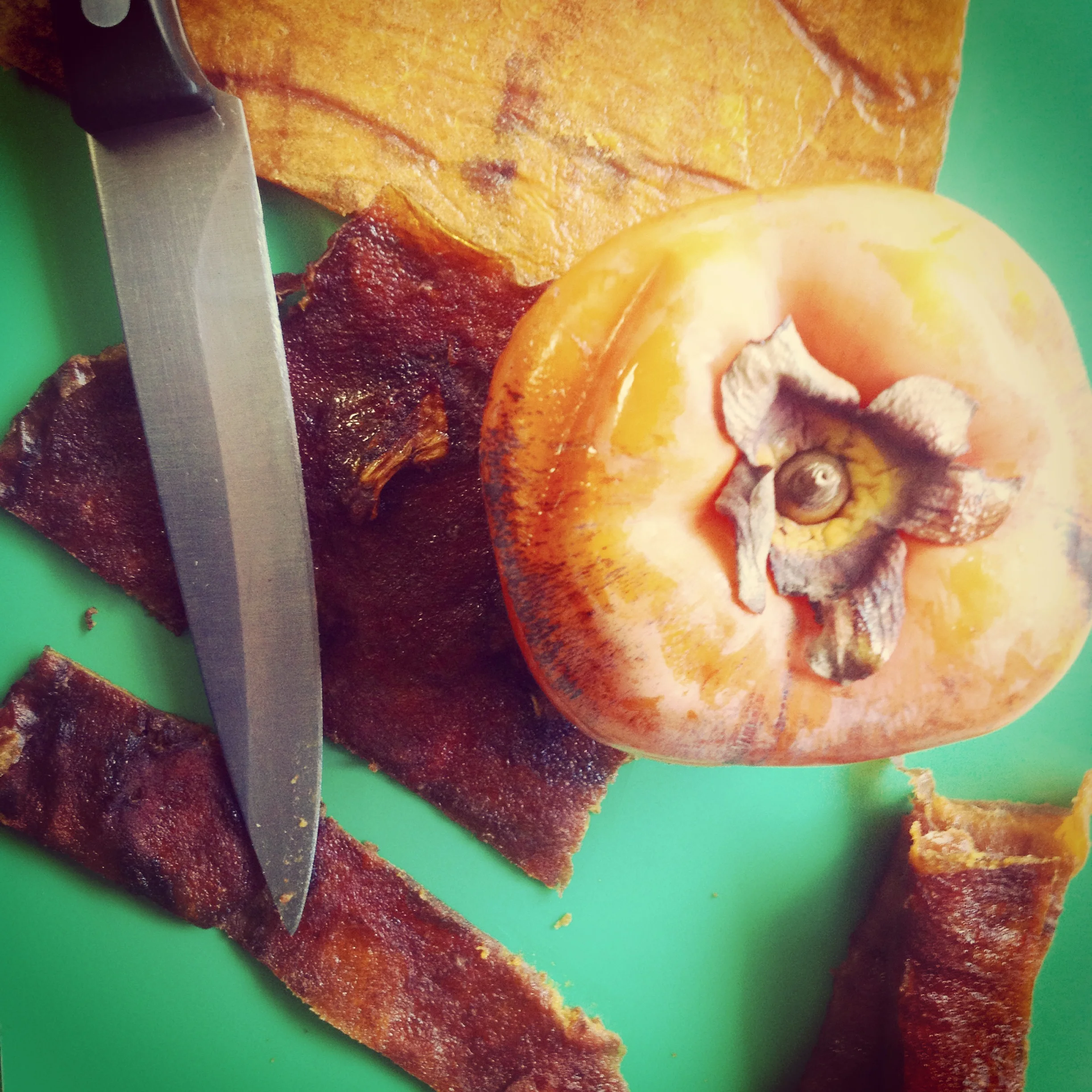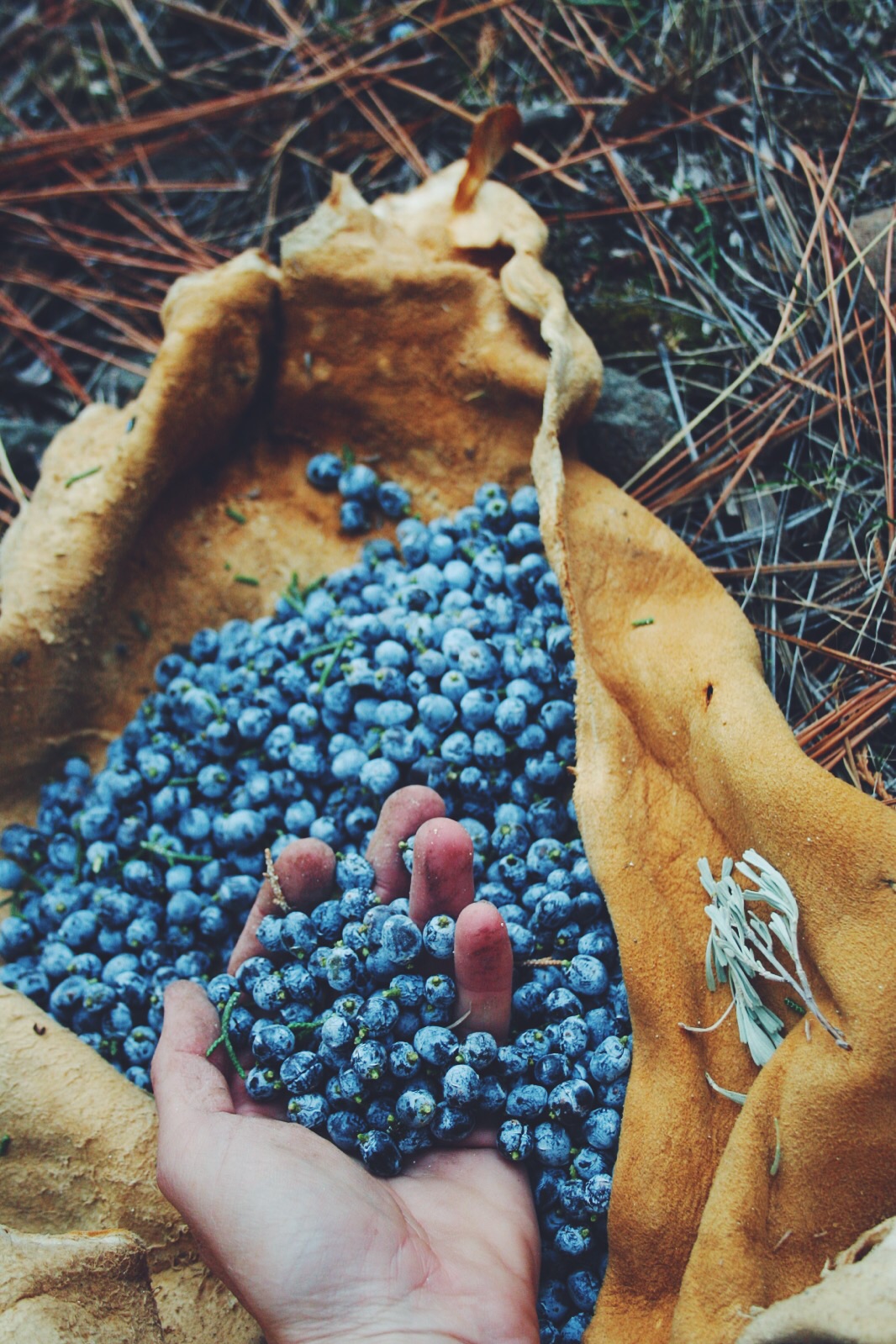Japanese persimmon (variety Hachiya) - watercolor 1917 drawn by Amanda A. Newton (USDA)
Persimmon is a small tree with a luscious edible orange fruit, technically a berry. The word 'Persimmon' is an alteration of a word originally coming from an Algonquian language of the native Powhatan of coastal Virginia meaning 'dry fruit' due to its tannic skins. Persimmon is wild in the southeast United States, and a planted edible cultivar of the West coast. Different Persimmon species are also native to parts of Asia, and southeast Europe. Persimmon has a cultural tradition of use in many parts of the world including the Middle East, Spain and areas of the Mediterranean. Recently, I made my annual batch of fruit leather from planted Asian varieties in California to stock up for the winter and next year's camping season. It's probably one of the tastiest fruit leathers ever. The sugars in the fruit condense during the process and the flavor strengthens. Across parts of Asia, methods of drying Persimmons vary including the more well known style of drying called hoshigaki. Different forms of the dried fruit can be found in markets and herb stores in especially in more populated urban areas, and pretty much everywhere on the West coast.
Ebony Plant Family (Ebenaceae)
Persimmon is in the Ebenaceae plant family. Of which, Persimmon and Ebony (which doesn't grow in the Southeast, but sometimes Persimmon heartwood is called Ebony) are probably the only two plants that folks in temperate North America would recognize. This plant family is usually associated with tropical and subtropical regions. Persimmon is of the Diospyros genus, meaning something like "God's Fruit" etymologically. The large edible Asian varieties of 'Fuyu' and 'Hachiya' most commonly sold in grocery stores are in this genus as well as the aforementioned wild Persimmon of the east, Diospyros virginiana. The 'Fuyu' and 'Hachiya' varieties are what I usually use to make fruit leather. Or, I slice and dry the fruit in chunks. They are planted all over California, sometimes in grand orchards, and now more often are found in suburban yards with large orange fruits decorating the tree even as the leaves have long fallen.
Diospyros virginiana, Wild Persimmon of the Southeast
Diospyros virginiana and a plow, from artist book "Oil and Rust" printed at Penland School of Crafts 2016.
I grew up with the wild Diospyros virginiana, the native Persimmon of the Southeast. In the Southeast, Persimmon can sometimes be confused with Black Gum, Nyssa sylvatica (Nyssaceae, Tupelo family) because of their similar entire leaf margins, leaf size and similar leaf vein structure, at least at first sight without further investigation. The wild Persimmon of the Southeast has smaller fruits than the Asian cultivated varieties and generally needs a few good hard frosts to render the plump orange fruits palatable enough to eat. Sometimes they make fruits that are ready a little earlier, and if you search the ground around the tree you can find them. They almost have to look rotten to be edible, or be 'bletted,' overripe even if a frost comes late in the season and hasn't hit them yet. The skins of most Persimmons but particularly this wild species are extremely astringent, but as fall moves into the winter, the astringency lessens. I just ate a handful of wild Persimmons right off the tree on my dad's farm in Virginia a few days ago in late December. While there was still a tiny tad of astringency in the skins, I still ate the whole thing pulling off the woody calyx and spitting out the seeds (I could save them for handmade buttons). The fruits start off the season a light green color and then turn a sherbert orange color over the summer. Then, they deepen their shade of orange into the fall. Once they have been hit with a frost or fully ripen, they get black splotches and the fruit is no longer round and plump.
Diospyros virginiana, from plant walk with Luke Learningdeer at Falling Leaves Rendevous, 2018.
Diospyros virginiana, from plant walk with Luke Learningdeer at Falling Leaves Rendevous, 2018.
In western North Carolina at Dancing Springs Farm where I used to live and work, we had several D. virginiana wild Persimmon trees on top of the hill sitting above the farm. Throughout the summer the farm dwellers and a few neighbors would tend to the area around the trees (getting rid of poison ivy) and make sure there was space to be able to go gather once the season for eating them arrived. Since there are generally no giant-fruited 'Fuyu's or 'Hachiya's planted in the area, these tiny fruits are a sought after gem for making pies, puddings and cookies. I see a lot more of Persimmon trees in the Piedmont region where I am from, mostly at the edges of fields or by ponds. But, wild Persimmon tends to have a wide range of habitats.
D. virginiana spreads by seed and root suckers. At my dad's farm, when the hay hasn't been cut yet in the Spring, you can see Persimmon sprouts dotting the field around the mother tree at the edge of the forest. Once the hay is cut, the saplings are cut too. They sprout back up every year, and if left to grow would eventually turn into full grown trees. Since they grow super slow, they are usually small trees. The wood is extremely hard and closed-grained because of its slow growth.
Asian Persimmon Diospyros kaki
Fuyu vs. Hachiya
Diospyros kaki is the Asian species of Persimmon, of which there are many cultivars. They produce much larger fruits than the southeastern Persimmon. They commonly get divided up into categories according to their level of sweetness and astringency. The two that I have seen the most around California are these two varieties that I have mentioned a few times already. Even though I have eaten and dried these varieties, I am still learning about their origins, culinary & medicinal uses.
A grafting side note: My dad used to sell Asian cultivated varieties of Persimmon trees at his nursery in southern Virginia where I am from, which were often grafted onto wild Persimmon root stock. Grafting is something my dad is really knowledgable about, and I literally need to sit down and take notes from him at some point to learn more. It is something I have never done or barely understand aside from my knowledge about plant families and related Genus' in relationship to grafting. He did it a lot because in the ornamental plant world and also the fruit tree world, grafting is a common practice. Often his grafting involved putting non fruiting species (like Bradford Pears) onto old root stock (an older heartier variety of Pear) to make a 'pretty' flowering tree without the 'mess' of fruits. Not MY jam, but interesting to learn about. In the case of Persimmon, the idea is to put a fat fruit producing fruit onto a native root stock that is adapted to the regional climate.
Rounded Fuyu with fruit leather made from the variety back in 2015.
The Fuju variety tends to be flatter and rounder and does not generally have astringent tasting skins. Even if they are not fully ripe, you can bite right into one and eat them like an apple. I have a friend with this tree in her back yard in the East Bay area (across from San Francisco) and for a few years I have gone to to collect them. One year, I ended up getting two trash bags full of the fruit and still didn't make a dent in the crop. From ONE tree. It is not usually the variety from which dried hoshigaki is made, but it could be done. I have made fruit leather from this variety, cut it into big and small chunks to dry for morning oatmeal camping or on the road. Usually for the fruit leather, I puree the persimmon sans seeds, or smash the very ripe fruits in a bowl and smush all together on waxed paper in a dehydrator. I don't cut it with anything like some other fruit leathers which I may add a dash of apple sauce for the pectin to hold together. Persimmon has tons of pectin on its own. This variety is best eaten fresh like an apple. They can be picked before finished ripening and stored until ripe, which is known by the deep orange colored skin and a slightly soft touch, but not as soft as the Hachiya gets. (For a member only write up on making fruit leathers, check out my Patreon to find the instructional post.)
Persimmon, Fuju variety.
The Hachiya variety is long and more cylindrical, sometimes a bit larger, and when it ripens it is extremely soft inside, to the point that some folks question whether it has gone bad. The skin will produce dark spots like the wild Persimmon of the Southeast, the usually astringent skin will tame. The texture of the skin will lose its tautness. My friend Heather originally told me about making hoshigaki and fruit leather from this variety. When she makes the fruit leather, she'll just squeeze out the innards of the persimmon onto waxed paper, making sure to pick out any seeds, and it is pretty much ready to dry in the oven on the 'dryer' setting or a dehydrator if you have one. Of course, the dashboard of a car on a tray could work too!
Japanese persimmon (variety Hachiya) - watercolor 1887 drawn by Amanda A. Newton (USDA)
Drying Persimmons Hoshigaki style - Hachiya variety.
photo credit: Sakurai Midori [CC BY-SA 2.1 jp (https://creativecommons.org/licenses/by-sa/2.1/jp/deed.en), GFDL (http://www.gnu.org/copyleft/fdl.html) or CC-BY-SA-3.0 (http://creativecommons.org/licenses/by-sa/3.0/)], from Wikimedia Commons
hoshigaki
A traditional method of slow drying Persimmons. The general idea is this:
cut the shoulders off of the fruits (or some leave them on), trim up the calyx, take off the skin of the fruit, and tie strings onto the remaining stems. Or, put a screw into the tops, if needed. You can hang two at a time with a fruit on each end of the string. Or one at a time, tied onto something.
keep hanging in a window or by a wood stove, and start squeezing gently on occasion after a week or so of drying.
the sugars in the persimmon will concentrate (like in the fruit leather too, when drying) as the fruit ripens more and dries.
after about a month of hanging and regular squeezing, presumably to break down the cell walls a little bit and allow a tiny bit of moisture flow, they will be ready to take down and store.
a sugar layer should bloom on the surface of the fruit when they are ready.
dried persimmons are LIKE CANDY!
GF Persimmon Quick bread Recipe
(created by Eric Davis, Bay area chef)
Ingredients:
2 cups GF flour (your choice of mix)
1/2 cup coconut sugar
2 eggs
2 cups Persimmon pureed, skins off
1/2 cup chopped dates
1 cup chopped walnuts or pecans
1/2 cup coconut oil or ghee melted
1/2 tsp baking powder
1 tsp baking soda
1/2 tsp cinnamon
1/4 tsp allspice
1/4 tsp nutmeg
1/4 tsp clove
1 tsp vanilla extract
1 tsp salt
Preparation:
Preheat oven to 350'.
Grease bread loaf pan with your choice of oil.
Make persimmon puree. Peel and de-seed persimmons. Any is variety okay, as long as they are ripe. Put in blender, puree but leave semi-chunky.
Start with 2 bowls. Wet and dry.
In the wet bowl, add eggs, sugar, vanilla extract, persimmon puree. Whip by hand until incorporated. Slowly add melted warm fat (ghee or coconut oil) whisking while you add (tempering oil into the mix, as to not cook the egg).
In the dry bowl, add GF flour mix, baking soda, baking powder, salt, spices and whip to incorporate.
Fold dry ingredients into the wet bowl.
Bake for approx. 35 minutes, until inserted toothpick or knife pulls out clean.
Let cool 20 minutes or more.
Also, college pal Renee Byrd of Will Frolic For Food blog has whipped up some crazy awesome Persimmon recipes with both the wild southern species and the Asian cultivated varieties. Check out her Persimmon Date Shake, which sounds amazing.
Medicine of the Persimmon tree
It isn't surprising that the suspected fruit of the 'Lotus Eaters' in Homer's The Odyssey is the Date-Plum Persimmon, Diospyros lotus. Persimmon's distinctive 4-lobed calyx has an artistic resemblance to a wild Lotus flower (Nelumbo nucifera). I wouldn't mind hanging around all day eating Persimmons either. (Another grafting side note: D. lotus, D. kaki, and D. virginiana can all be grafted onto one another, just so you know)
In Traditional Chinese Medicine, Persimmon's calyx is the main medicinal part used and referenced actually, not the fruit. It is called Shi Di, and is sometimes just called Kaki, after it's species name. It is seen as having a neutral nature but is very bitter and astringent like the fruit skins, leaves and bark and is often used for coughs, hiccups and nausea.
The Persimmon fruit has huge amounts of Vitamin A, important for the Fall season moving into Winter. Vitamin A is also found in other orange foods like sweet potatoes and winter squashes, which are ready to eat in fall, too. Regular Vitamin A in the diet strengthens the immune system, soothes inflammation in the digestive tract, has anti-aging and anti-cancer properties. Persimmon fruit has a slight astringency, but also a slight mucilage. With that combination of actions, eating the fruit can tighten and yet soothe irritated digestive mucosa. It also contains a bit of Vitamin C and Iron and is a great food for anemics to incorporate into their diet. It is seen as moving things by improving blood flow and reducing blood pressure, as well as helping to reduce gout. Eating a slightly unripe Persimmon fruit can help stop diarrhea, given the slight astringency of still present tannins in the skins.
Persimmon bark and leaves contain Betulinic Acid, like Birch Bark (Betula spp, Betulaceae). Like the fruits, the bark has anti-inflammatory properties that reduce the chance of cancers and other diseases. It is highly astringent like the skins and calyxes and is used in an infusion for diarrhea and hemorrhoids, again, tightening irritated mucosa. It is also used as a gargle for sore throats and a first aid herb for slowing bleeding. Most of these medicinal uses are common knowledge in TCM, but not so much in Western traditions of herbal medicine.
A tea of the leaf is commonly drank in China and Japan (and also used in food) for its delicate flavor, metabolic reset, anti-aging properties & for dealing with seasonal allergies. I haven't researched this, but It seems to make sense that some of Persimmon's constitutional qualities would reduce the effects of seasonal allergies, acting on mast cells and histamine reactions at least inadvertently- reducing inflammation which is huge during pollen season and soothing to already irritated mucosa. Also, taking Vitamin C during allergy season is helpful, and as Persimmon contains a good amount of Vitamin C, this makes sense. I suppose I could save my fruit leather for allergy season if I found myself back in a land of lots of pollen dropping Pines and deciduous trees this year during allergy season, because I get it BAD.
The last thing with Persimmon. I am pretty obsessed with natural dyes, and usually something that is highly tannic also works as a natural dye, or for bark tanning leather. Also, tannin can be used as a mordant which is essential when dyeing fabrics or yarns made of plant fibers as the mordants act like a bridge between the fibers and the color. Thus, Persimmon leaf, bark or calyx (or skin I suppose) acts as a natural mordant, and can theoretically be used as a pre-soak for natural dyeing. Here's a little blog post I found on it if you want to explore or experiment.
Pledge on Patreon to support this work.














































